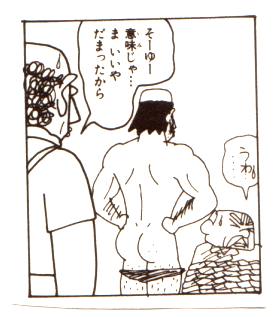Azuma has put up the latest really, really long post on the Classical Japanese verb in the ongoing dialogue. I've commented on bits and pieces over there, but my response to the main thrust is a bit too long, so here it is.
After a lot of paging through dictionaries, I have come to agree with the idea that C-verbs (e.g. 咲く, sak) and V-verbs (e.g. 見る, mi) resemble each other more closely than the D-verbs (e.g. 起く, ok/e, 明く, ak/e) resemble either one of them. However, I do not think that the D-verbs are the older form of the C-verbs. No, I believe the opposite. This is because the /i/ and /e/ that sometimes attaches to the stem of D-verbs are not random -- they carry semantic meaning.
Those meanings are:
- /i/ -- signifies intransitivity of the verb
- /e/ -- signifies transitivity of the verb, OR "passive intransitivity" (usually a non-voluntary change in state)
(There may be a better way to put this -- /i/ signifies a verb with only an agent, and /e/ signifies a verb with a patient?)
An archetypical and extremely handy example of this behavior is provided by verb-forming morpheme pairs, like -om vs. -om/e (kurom, to go black, vs. kurom/e, to turn (something) black), -rag vs. -rag/e (irarag, to be(come) sharp, vs. irarag/e, to sharpen (something)), yag(e), am(e), etc. etc. I have not yet found an example of these suckers letting my theory down when it comes to C vs. D/e behavior.
The "passive intransitive" /e (ak/e -- (day) breaks; tok/e -- (something) is loosened, solved, released; as/e -- (something) fades) is an interesting case. I am positive that it is related to the passive r/ar/e ending that attaches directly to the stem. Perhaps /e was also able to attach directly to the stem at some point, but lost this ability.
Is the p.e. /e related to the transitive /e? Maybe. They behave differently, and there is this very interesting tendency to consider:
| transitive | intransitive |
|---|
| ar | /e |
| ar/e | as, at, C-stem, but not /e |
This is not an iron-clad rule, and it may just be that I'm looking at a misleading subset of verbs, but I think what we're seeing here is that -ar means "to be(come)", -ar/e means "to be caused to be(come)", while plain /e is with the as/at/C-stem gang meaning "to cause or permit a change in another". That is to say, it may be that ar means "become", with /e signifying the presence of an Undergoer-external Catalyst of that change. This would tie the p.e. /e up neatly as well -- it's just a freak of grammar, not really transitive but treated that way because the Catalyst is unspecified (or unspecifiable!)
(I'll put my treatment of exceptions to the /e = transitive or passive rule in comments, and invite you to challenge me with others.)
/i is much more clear-cut -- I can't find a single counter-example to the intransitivity rule, except for 恋ふ, koh/i, which -- guess what -- used to be intransitive (with an "inspiration" indicated with ni.) Behold, my new Manyoushuu-searching technique is unstoppable.
妹に恋ひ我が泣く涙敷栲の木枕通り袖さへ濡れぬ
imo ni kohi / wa ga naku namida / shikitahe no / komakura tohori / sode sahe nurenu
"The tears I cry intoxicated with you, my darling, go through my wooden pillow and soak my sleeve."
This tanka makes me think of Ripley from Aliens shouting "Damn you, I told you not to sadden the poets! They have acid for tears!" at panicky space marines, but I think it illustrates pretty clearly how the verb koh used to work. It was something one did oneself, inspired by another (but not directly caused by them!)
Anyway, this is why I think the C-stems are the older forms. Since the /i and the /e contain only meta-meaning, they can only be attached to a stem that already has meaning in and of itself. There's also some textual evidence: 生く ik (live) appears as far back as the Manyoushuu, but ik/i isn't attested until (late) Heian times, to say nothing of modern iki. ik/e is also a Heian innovation.
Obviously, the the /e-verbs' appearance can be explained by grammatical necessity, but I'm not sure about why the /i-stems should have appeared to replace perfectly good C-stems (and replace them they did, it seems -- ik/i is the only one I know of that co-exists with a C-stem equivalent; anyone got any others). It may have been a sound-driven change; most of them seem to be attached to stems containing an /o/ or a /u/. (Again, ik/i is the exception, dammit.)
So what am I going to do about it?
We are getting far beyond the point of simplifying things to a more readily memorizable form, so let's go crazy. I am going along with Azuma's broad division of CJ verbs into two types. For want of a better term, let's call them Grumpy and Happy. (I want to save Irregular for the true exceptions, and I want to use initial letters I haven't yet. Deal with it.) Grumpy verbs are those whose stem is invariant, i.e. C-verbs and V-verbs in my old analysis. You can't mess with a grumpy verb's stem. It will just shout "get off my lawn!" and possibly cause the cops.
Happy verbs have a consonant stem, but to this is attached a vowel, either -i or -e. This vowel has not fused with the stem yet, so it's still a bit weak and susceptible to change. (We can see here that Grumpy verbs can become Happy, or divide into a Grumpy/Happy dyad if necessary.) Then we conjugate all verbs like this:
form | ending
after vowel | ending
after consonant |
|---|
| MZ | 0 | a |
| RY | (i) | i |
| SS | ru | u |
| RT | ru | u |
| IZ | ru | e |
| MR | yo | e |
Note that I'm not sure about Azuma's MZ ending = always 0 thing (it works out the same, though), but I do think it makes sense that the RY ending is always i. After vowels, it's realized as 0, though: i + i = i; e + i = e. These vowel equations work for me. I'm not even going to get into the MR form, but I do think Azuma has some very interesting ideas there.
This table would lead us to suspect that, say, the Happy verb sug/e (to cause something, esp. thread, to pass through) would have SS, RT and IZ forms of sugeru, sugeru and sugere, respectively. Not so; they are sugu, suguru and sugure. Why?
There are two main possible reasons I can think of for the RT/IZ discrepency:
- RT/IZ are built on the SS form, not stem
- RT/IZ endings have a deforming effect on the preceding vowel, mushing it into a /u/ if it is not part of the stem (i.e. if the verb is Happy)
(You will notice I have abandoned my theory of C-stem + V-ending. I don't think it makes sense any more.)
I prefer the second explanation here, because it neatly explains why all those Happy verbs began to straighten up and fly right over the course of the past millennium -- as the /i and /e endings became so old that they were simply integral parts of the verb, the RT/IZ endings' vowel-mushening powers became less effective. In other words, as they got older, the Happy verbs all became set in their ways and Grumpy. The anthropomorphism of this appeals to me.
As for the SS thing... my best idea here is that the SS ending is "strict" and rejects optional vowels. This would make it unlike all the other endings but on the other hand, SS is unlike all the other endings in that it was unstable and replaced by the RT form. Maybe this was part of its instability.
Or maybe the SS is not a verb ending at all but rather a "verb phrase" ending -- i.e. there is no SS ending as such; rather, verbs in final position are used as raw stems plus an u/ru which signifies "verb phrase ends here". Since the idea is to use raw stems, the /i and /e (meaning-carrying postfixes, not part of the stem as such) are not added, and you end up with a word ending with a consonant which takes the /u.
These kind of bizarre, non-mora-friendly shenanigans could also have caused the SS form's demise -- or, it could be that once the Happy verbs became Grumpy, the /i and /e were no longer postfixes but rather officially part of the stem, in which case the SS form would have merged perfectly with the RT form rather than being "replaced" by it. The SS form could be living among us even as we speak. It could be in a sentence your neighbour is writing... right now.
But what about the exceptions?
First, the big pain in the ass: the 死ぬ, sin/0, group. I propose that we reanalyse these as Grumpy, and assume that their RT/IZ peculiarities are to do with the fact that Japanese has an /n/ that can occur as half of a mora and also an /N/ that is an entire mora of itself. I.e. sinuru comes not from sin.u.ru but rather siN.ru, via processes that need not concern us here. (As evidence that this is a phoneme thang, I offer the fact that there are no Grumpy verbs with a stem ending in /n/ that do not display this weirdness.)
su/ku: Happy verbs whose optional vowels are extra-weak and lose out even to the RY -i ending. That, or true, unanalyzable (to me) exceptions.
ar.i: Grumpy verbs with a variant SS form, possibly related to the -si as the SS ending for adjectives.
What I really want now is for people to find exceptions to my rules for what /i and /e do, to see if they can be explained away somehow.
![[No-sword]](http://no-sword.jp/images/site/no-sword_banner.jpg)






